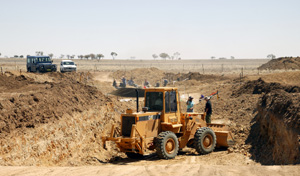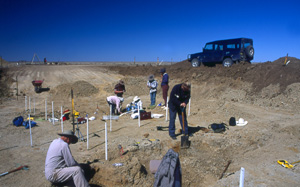The 2003 Elliot dig

The 2003 Elliot dig took place during the first two weeks of September. In addition to members of the Elliott clan, 21 people participated. Dr Steve Salisbury (The University of Queensland), Dr Alex Cook (Queensland Museum) and Damien Munro (UQ /QM) were there for the full duration of the dig, as was Jewel Karpel, who once again flew in for the occasion all the way from New Mexico in the US. Joanne Wilkinson (QM) also put in a long stint, but had to leave half way through the second week to be with her family. Tim Holt (an undergraduate student at UQ), Kylie Piper (Sydney), Libby Manual (Sydney) and Joan Rassmussen (Brisbane) joined the team during the first half of the dig, and helped set up the site. During the second week of the dig, the latter three switched places with Scott Hocknull (QM), Kerry Geddes (formerly with the QM, but now at UQ), Chris Glen (a PhD candidate at UQ), Stewart Macdonald (an undergraduate student at UQ) and Perth's ever-smiling Yolanda Pereira. Also there during the second week were Gregor Stronach, on hand to catch all the off-road action for Overlander 4WD Magazine, and UQ photographer Chris Stacey.

Industry Partner for the Winton Dinosaur Project, Land Rover Australia, kindly provided the team with two vehicles: a 2002 Discovery Td5 and a Defender Td5 Extreme. The QM's workhorse, the trusty ?Dino Defender', was also there. Winton Shire Council provided tables and chairs, and helped transport equipment to the site. Alan Smith and Trish Sloan from Outback Aussie Tours, Longreach, provided catering for the hungry dino-diggers, as well as whip-cracking demonstrations during smoko breaks. Alan's uncle, Ian Tidswell also helped with catering, and showed us the finer points of operating the K9 Dingo Mini-digger, kindly lent to us by the Dingo team at Dalby.
During the 2002 dig we located the siltstone horizon in which the sauropod bones were preserved. The 2002 pit encompassed an entire quadrat (10 x 10 metres), and went down to a depth of around 1.2 metres. The bones occurred in an east-west band, about three or four metres across. The goal of this year's dig was to follow this fossil-bearing horizon to the east and west of the 2002 pit.

After Dave had removed all the overlying blacksoil with his loader, it didn't take long before bones began to emerge from the siltstone. The pace of discovery continued for several days, with only a slight lull towards the end of the first week. Things got going again during the second week, and after 14 days digging we had amassed 27 jackets, containing at least the equivalent number of bones. Probably about half of these will prove to be identifiable once they have been prepared. Some of the better-preserved bones include sauropod limb elements and vertebrae, and parts of what look to be medium-sized turtles and crocodilians. On-site sieving of the sediment associated with the bones was done by Alex, Damien and Scott, and also proved to be productive, with numerous crocodilian teeth and many small fragments of bone being found.
» View a short movie highlightling some of the work that took place during the 2003 Elliot dig.
» You can also read Gregor Stronach's riveting firsthand account of the 2003 dig in the December issue of Overlander 4WD Magazine.
